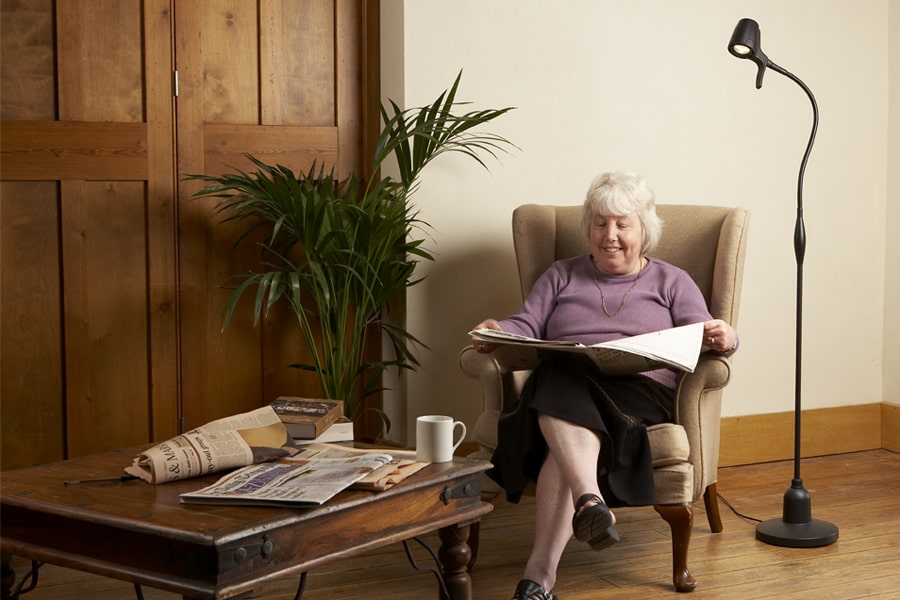How your eyes age and how to help
Our eyes are put through a lot during our lifetime.
As such a key element to our lifestyle and general wellbeing, our eyes are fundamental. Naturally, as we age, our eyes do too and as a result, our visual acuity declines. What conditions might our eyes develop as we go through life? We have listed a few of the most common conditions, so you know what to look out for.
Beginning to decline – your eyes at 40
Once you reach the age of 40, your eyesight will begin declining gradually. The changes might not be noticeable at this stage but will start to take effect.
Signs to look out for
There is an increased risk of dry eye at this stage in your life. Your eyes won’t be able to lubricate efficiently, and you will often feel the need to rub your eyes.
Eyestrain could become a big issue at this age due to constant screen time, whether that’s a digital screen at work or a mobile phone screen.
Presbyopia is normally identified in people after they reach the age of 40. Usually, one of the first symptoms is struggling to focus on objects close to you.
Cataracts may begin to develop at this age but they won’t usually start to impair your vision until your 60s.
Accelerated decline – your eyes at 50
Once you hit the milestone that is your 50th birthday, you’ll be more cognisant of the changes to your eyesight. What you experience at this stage is similar to your 40s, but conditions now develop much more quickly.
Signs to look out for
You may experience distorted vision in the centre of your field of vision due to macular degeneration (AMD). AMD is the leading cause of vision loss in people over the age of 50.
The gradual loss of your peripheral vision may begin to occur, which could be a potential sign of glaucoma.
Seeing detail will become increasingly difficult. This will often lead people to require glasses or contact lenses at this stage if they haven’t needed them already.
Dry eye is an increased risk at this age. It could continue to affect you as you age due to your tear ducts functioning insufficiently.
Eye conditions developing – your eyes at 60
Most eye conditions will often be known or diagnosed by the time you’re 60. You could be looking at different treatments to prevent the onset of further eye conditions or to reduce the speed of visual degradation.
Signs to look out for
You may notice specks or patches of red in your eye. These are new blood vessels that may grow and bleed into the centre of the eye, causing serious vision loss or blindness. This eye condition is called diabetic retinopathy. If you have had diabetes for some of your life, then you may be at an increased risk to this condition at an elderly age.
If you have been driving for most of your life, this is the age where you may find difficulty driving as your vision and depth perception will have reduced significantly.
There is a high chance that floaters will become an issue. This can be normal at this age, but in some cases can be an indication of an underlying condition like retinal detachment.
This is a condition where the inner and outer layers of the retina become separated. Floaters will normally be noticeable in well-lit surroundings.
Your ability to see in low light will also significantly reduce. Unless in clear daylight or well-lit rooms, you may struggle with your vision to some extent.
 Highest risk – your eyes at 70+
Highest risk – your eyes at 70+
This is the age where you are most likely to develop an eye condition. Most eye operations and corrections are performed when you are in this age bracket.
Signs to look out for
You will likely lack the ability to focus on items that are close to you due to the advancement of presbyopia. You might need a visual aid to alleviate the symptoms depending on their severity.
If you haven’t developed it already, the glaucoma risk is heightened again. Every 1 in 50 white Europeans has some form of glaucoma at 70. You may experience very strong blurring in your vision and need to look for visual aids to help your eyes adjust.
You will have even higher risks of acquiring one of the common eye conditions listed on page 4 once you hit 75. In the UK, one in five people over the age of 75 live with sight loss, and a further one in every two people at the age of 90.
The ability to process colour in your vision will decline once you hit this age. As well as this, you will mostly only be able to see directly in front of you, due to your visual fields narrowing.
Treating your eyes – Options to consider
There is no treatment for dry AMD, but you can aid your condition by ensuring you have bright, natural reading lights.
For cataracts and glaucoma, surround yourself with a light that is as natural as possible. A strong, natural, dimmable reading light directed specifically on to the point of focus can improve clarity.
This is where a Serious Light can help. Designed and hand-crafted in the UK – using bespoke Daylight Wavelength Technology™ and offering crystal clear clarity, Serious Lights are made with eye conditions in mind.
The High Definition is our closest light to natural daylight boasting a colour rendering index score of 99 out of 100 as well as being recommended by over 500 independent opticians.
For a limited time only, Silversurfers readers receive an exclusive offer of £100 off our High Definition range in the stylish and sleek white finish – with a bonus addition of free delivery worth £9.95. See our Discounts+ section for more information.




















